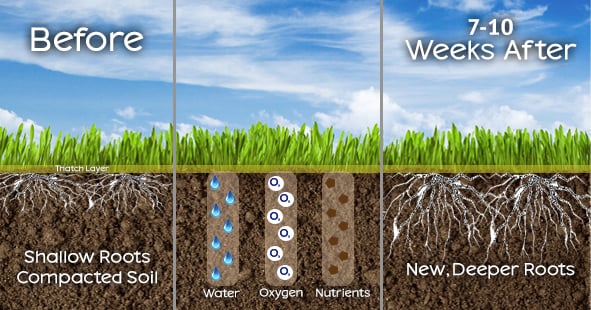The Benefits of Lawn Aeration
At [Company Name], we understand the importance of maintaining a healthy and vibrant lawn. One crucial aspect of lawn care that often goes unnoticed is lawn aeration. In this article, we will delve into the numerous benefits of lawn aeration and how it can help you achieve a lush and thriving lawn.
Enhanced Nutrient Absorption
Lawn aeration plays a vital role in improving nutrient absorption for your grass. By creating small holes in the soil, aeration allows nutrients, water, and oxygen to penetrate deeply into the root zone. This enables the roots to access vital nutrients more effectively, promoting healthier and greener grass growth.
Improved Soil Structure
Over time, the soil in your lawn can become compacted due to factors like foot traffic, heavy machinery, or even natural settling. Compacted soil restricts the movement of air, water, and nutrients within the soil, leading to poor root development. Lawn aeration helps alleviate soil compaction by loosening the soil, allowing it to breathe and absorb moisture more efficiently. This, in turn, promotes stronger root growth and overall soil health.
Enhanced Water Drainage
Excessive thatch buildup or compacted soil can hinder proper water drainage in your lawn. When water is unable to penetrate the soil effectively, it can lead to surface runoff, puddling, and even waterlogging. Lawn aeration helps improve water drainage by creating channels that allow water to seep into the soil more easily. This prevents water from pooling on the surface and promotes healthier grass growth.
Reduction of Thatch
Thatch refers to the layer of dead grass, roots, and other organic matter that accumulates between the grass blades and the soil surface. While a thin layer of thatch is beneficial as it acts as a natural insulator, excessive thatch can become problematic. It can prevent water, air, and nutrients from reaching the roots, leading to weak and unhealthy grass. Aeration helps break down thatch by introducing oxygen and promoting the decomposition of organic matter, resulting in a healthier lawn.
Enhanced Root Development
Aeration stimulates root growth by providing an optimal environment for roots to expand and develop. As the soil becomes less compacted, the roots can penetrate deeper, accessing more nutrients and water. This leads to stronger, more resilient grass that can withstand drought, disease, and other environmental stresses.
Improved Overall Lawn Health
By addressing common lawn problems such as soil compaction, poor nutrient absorption, waterlogging, and thatch buildup, lawn aeration contributes to the overall health and vitality of your lawn. Regular aeration can help prevent and alleviate these issues, ensuring that your lawn remains lush, green, and beautiful throughout the year.

In conclusion, lawn aeration is a crucial practice that offers numerous benefits for maintaining a healthy and vibrant lawn. By promoting enhanced nutrient absorption, improving soil structure, enhancing water drainage, reducing thatch, stimulating root development, and improving overall lawn health, aeration can help you achieve the lush and thriving lawn you desire.
Frequently Asked Questions
1. What is lawn aeration?
Lawn aeration is the process of perforating the soil with small holes to allow air, water, and nutrients to reach the grassroots.
2. How often should I aerate my lawn?
The frequency of lawn aeration depends on various factors such as soil type and foot traffic. Generally, it is recommended to aerate your lawn once or twice a year.
3. What are the benefits of lawn aeration?
Lawn aeration helps in reducing soil compaction, improving water and nutrient absorption, promoting healthy root growth, and enhancing overall lawn health and appearance.
4. Can I aerate my lawn myself?
Yes, you can aerate your lawn yourself using a manual or motorized aerator. However, it may be more efficient to hire a professional lawn care service for larger lawns.
5. When is the best time to aerate my lawn?
The best time to aerate your lawn is during the growing season when the grass is actively growing. Spring and fall are generally considered ideal times for lawn aeration.
6. Will lawn aeration help with thatch removal?
Yes, lawn aeration can help in reducing thatch buildup by breaking up the thatch layer and promoting decomposition. However, severe thatch problems may require additional treatments.
7. Can lawn aeration improve water drainage?
Yes, by creating channels for water to penetrate the soil, lawn aeration can significantly improve water drainage and prevent waterlogging issues.
8. How long does it take to see the benefits of lawn aeration?
The benefits of lawn aeration can vary depending on the current condition of your lawn. In general, you may start noticing improvements within a few weeks to a couple of months.
9. Is overseeding necessary after lawn aeration?
Overseeding is highly recommended after lawn aeration as it helps in filling in the aerated holes with new grass seed, promoting thicker and healthier turf.
10. Can lawn aeration help with weed control?
Lawn aeration indirectly helps with weed control by improving the overall health of your lawn. A healthy and dense turf is better able to compete with weeds, reducing their growth and spread.




